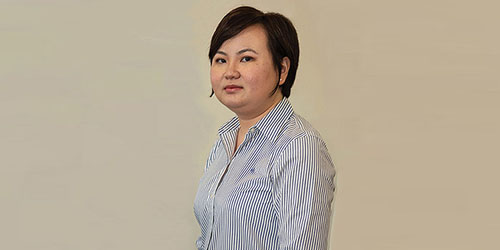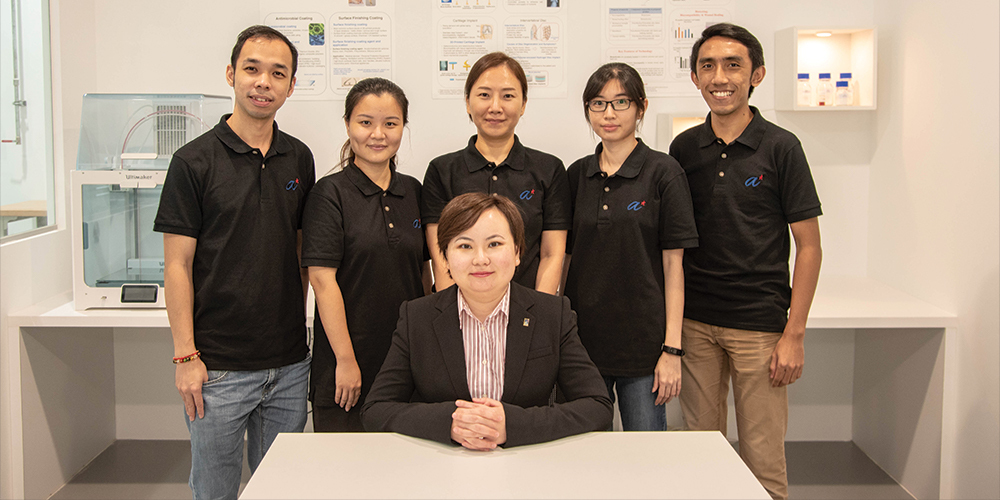FACES OF A*STAR
Contributing to Better Health Outcomes in Singapore
The best solutions are multi-faceted. Therefore, the A*STAR Horizontal Technology Coordinating Office tackles national challenges in food security, healthcare, sustainability and more, by pulling together multi-disciplinary capabilities that cut across an array of A*STAR research institutes and programmes.
In this series, our researchers share the national challenges they are passionate about solving, and how they are developing innovations across disciplines, to create growth and improve lives.
The fulfilment when new technologies are created to benefit mankind, especially in the medical technology space, is what drives Dr Teo Peili, Senior Scientist at A*STAR’s Institute of Materials Research and Engineering (IMRE).

Tell us more about your area of research
My research area is on biomaterial development for medical devices. Six years ago, I was looking to apply my skillset in organic-inorganic synthesis and found biomaterials to be interesting. It has a great direct impact on a patient’s health through improvement of healing outcomes such as tissue regeneration for enhanced wound healing.
In particular, what issues are you hoping to address with your research?
I am passionate in developing intervention solutions for osteoarthritis patients. Through my research, we are looking at creating better bone and cartilage implants that will help to promote regeneration of tissues. Osteoarthritis is common in an aging population. By carrying out interventional treatments, we can preserve mobility and thereby quality of life.
Through my research, I am also working towards providing solutions in chronic wound treatments, such as those for diabetic ulcers, venous ulcers and pressure ulcers. Chronic wounds are a major healthcare burden globally. Our acellular therapies for enhanced wound closure are aimed at improving chronic wound management, affordably.
Who do you look up to when it comes to this area of research?
Professor Robert H. Grubbs, my postdoctoral supervisor has always been my source of inspiration. He taps on catalysis to come up with materials that are useful to mankind. His determination in developing the right catalysts to make these materials is most admirable.
It was this determination that led him to develop the famous Grubbs’ catalyst for olefin metathesis, which won him the 2005 Nobel Prize in Chemistry. This also led me to take his technology in olefin metathesis further to create a whole series of biomaterials for medical devices.
Could you share some examples of multi-disciplinary collaborations in your research?
Collaborative research across A*STAR research institutes are a must as we tap on each other’s expertise to advance our research in orthopaedic implant development. For example, my team develops the materials for implants and 3D prints them. The Bioprocessing Technology Institute (BTI) team then runs the blood flow simulation for optimum cell penetration in the bone scaffolds for tissue regeneration. Singapore Immunology Network (SIgN) colleagues will test the immunotoxicity of the implants to make sure they are safe for human use. While the Institute of Molecular and Cell Biology (IMCB) researchers study the histopathology of tissue samples to determine extent of cartilage and bone regeneration.
We also partner local hospitals to ensure that the implants we create meet clinical needs and solve problems faced by osteoarthritic or bone defect patients. We too work closely with dermatologists and vascular surgeons to develop effective and cost-efficient wound care products.

Dr Teo (middle) and her research team who are developing implant materials.
What are some of the key challenges facing scientists working in your particular field of research today?
Medical technology (medtech) research is very challenging as development costs tend to be very high. The gestation period for the product is also long due to the need for stringent bio- and clinical validation before clearance by regulatory bodies. To keep going, I always remind myself that the development would ultimately benefit patients and improve their lives.
What are some of your proudest moments in your career so far?
It would be my work in 3D-printed medical device. We successfully developed a 3D-printed medical face shield in partnership with Siemens during circuit breaker in April 2020, in just two months. When the product was launched, I felt really proud of my team for coming up with something useful in such a short time. The product was shared with Tan Tock Seng Hospital (TTSH) and several other government agencies.
What are your observations of the local R&D ecosystem and how has it evolved?
The local R&D ecosystem is certainly maturing: there are greater collaborations between researchers from different domains compared to a decade ago. Researchers are more actively looking into the translational value of their work instead of just carrying out pure academic research. The local R&D ecosystem is a small community. By pulling together all our capabilities, we will be in a better position to develop useful solutions for Singapore’s multi-disciplinary national issues, be it in healthcare, food security or climate change.
What would you like to achieve in your scientific career in the next five years?
I would like to be a research leader in the medtech space, especially in medical device development using biomaterials and/or 3D printing. I would also like to run medtech programmes that gel various capabilities in the ecosystem together, to tackle national healthcare problems that can benefit from advancements in medtech devices.
Was this article helpful?
A*STAR celebrates International Women's Day

From groundbreaking discoveries to cutting-edge research, our researchers are empowering the next generation of female science, technology, engineering and mathematics (STEM) leaders.
Get inspired by our #WomeninSTEM
